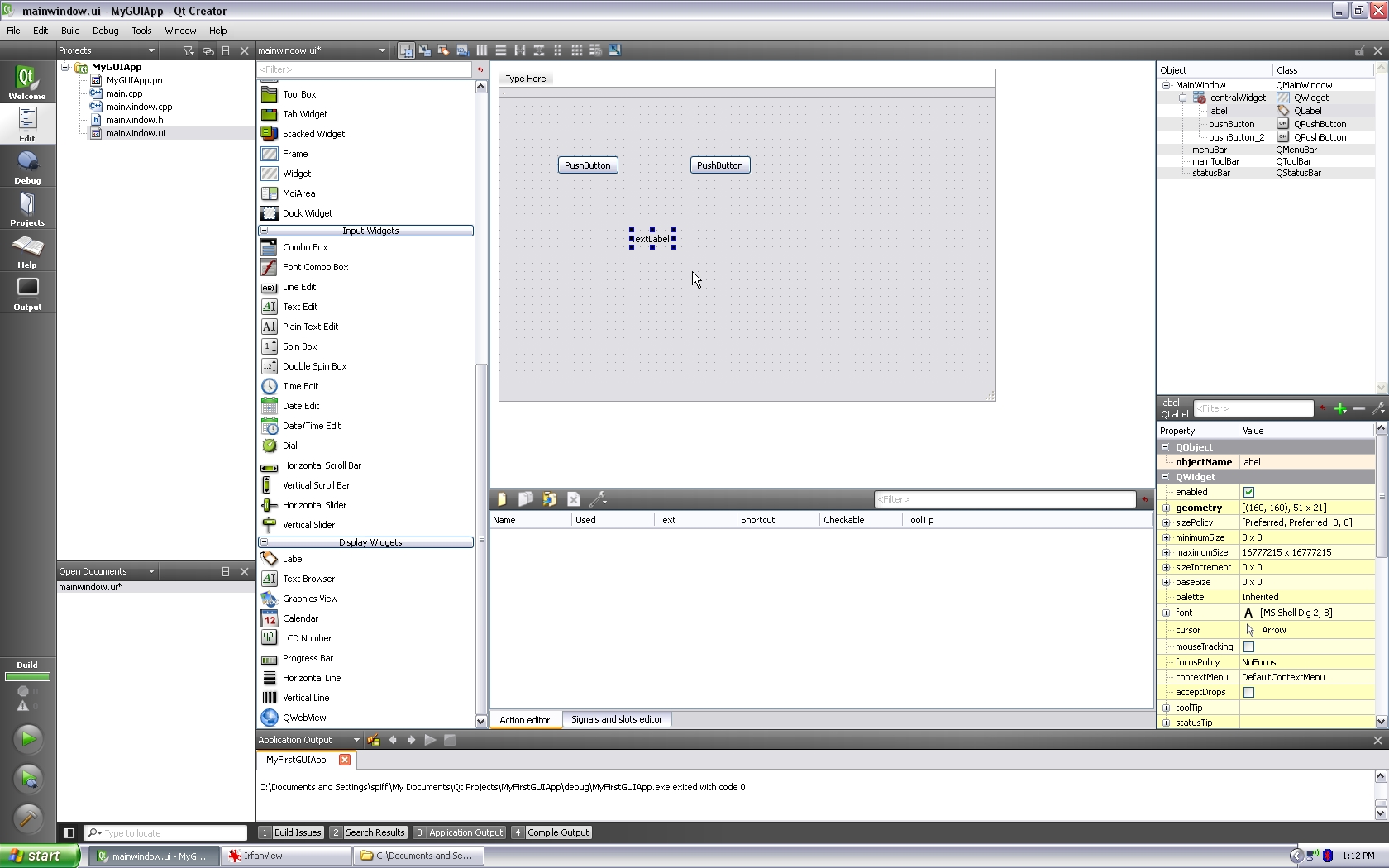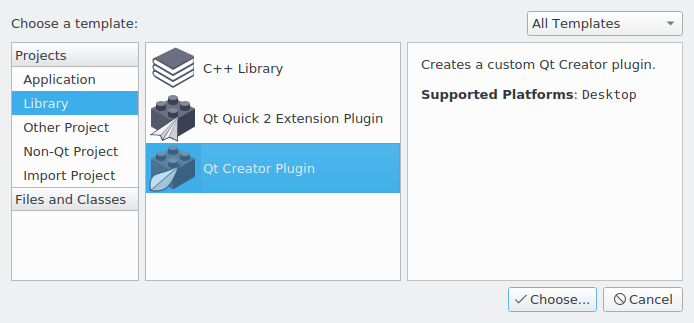Creating Custom Widgets for Qt Designer Qt Designer 's plugin-based architecture allows user-defined and third party custom widgets to be edited just like you do with standard Qt widgets. All of the custom widget's features are made available to Qt Designer, including widget properties, signals, and slots.
(C) 2009- Jason Leigh- University ofIllinois at ChicagoMainSteps:
1. LaunchQt: When you launch Qt Creator, it should look like this.
2.Create a new Qt Application: Goto File menu and select New. In the dialog box select Qt4 GuiApplication.
A number of dialog boxes will appearto ask you to specify a name for your project and a location to put it.
... and the modules you want toinclude... for now all you need are the default modules.
After this dialog boxes there will betwo more. Just go with their defaults.
Qt will then create a bunch of fileslike: MyGUIApp.pro, main.cpp, mainwindow.cpp, mainwindow.h,mainwindow.ui.
3.Design the User Interface:Click on mainwindow.ui to bring up the interface designer.
Using the interface designer add 2push buttons and a text label (by clicking and dragging those itemsfrom the widget palette) to the main window widget.
4.Connect Signals to Slots:Under the Edit menu, select 'Edit signals/slots'- You are now inSignal/Slots editing mode.

Click and drag (and release) from PushButton 1 to somewhere on the main window's widget.
A dialog box will appear asking you toconfigure signals and slots. On the left are signals emitted by a pushbutton. On the right are signals currently received by MainWindow.
We are going to connect the'clicked()' signal to a custom slot of our own called 'button1Pressed()'
Click on the 'clicked()' item on the left. Then click on 'Edit' on theright.
Click on the big green '+' to add anew slot for MainWindow. Type in 'button1Pressed' into the entry boxwhen it appears.
Once you're done, select'button1Pressed()' as the slot to receive the signal 'clicked()'. Thenaccept this by pressing OK.
Your GUI should look something likethis. Notice the red highlighted items showing the signal and slotsthat are connected together.
Repeat the above steps to create aslot to handle Push Button 2 called 'button2Pressed()'
The GUI should now look like this...
5.Add the code to handle the button1Pressed()and button2Pressed() slots: Click on mainwindow.h and insertthe member function declarations code for the slots.
 Click on mainwindow.cpp and insert theactual code of the member functions button1Pressed() andbutton2Pressed(). All I want to do in this example is to change thetext in label widget to reflect that I have pressed a button. I amdoing this be explicitly writing: ui->label->setText('Button1');
Click on mainwindow.cpp and insert theactual code of the member functions button1Pressed() andbutton2Pressed(). All I want to do in this example is to change thetext in label widget to reflect that I have pressed a button. I amdoing this be explicitly writing: ui->label->setText('Button1');I could have been more elegant and declared a new signal forMainWindow, perhaps called UpdateLabel(char*) and instead said: emitUpdateLabel. Then I can connect UpdateLabel to the label'sSetText(char*) slot.
6.Compile and Run the program: Clickthe Green Arrow near the bottom left of the screen to get your programto compile and run.
The main window should launch. Click on the two push buttons to seewhat happens to the label.
Oh by the way, notice the filescreated by Qt. Qt Creator automatically created the .pro (project)file. The Designer created the .ui file. And Qt's User-InterfaceCompiler (uic) created the ui_mainwindow.h file.
Also if you look at theui_mainwindow.h file you can see the code generated by Qt for yourwidgets. Notice in particular the connections between the signals andslots.
Qt5 Tutorial Signals and Slots - 2018

In this tutorial, we will learn QtGUI project with signal and slot mechanism.
File->New File or Project...
Qt Creator Tutorial
Applications->Qt Gui Application->Choose...
We keep the class as MainWindow as given by default.
Next->Finish
Qt Creator Online
Let's open up Forms by double-clicking the mainwindow.ui to put gui components:
From the Widgets, drag Horizontal Slider and Progress Bar, and place them into the main window. Then,
Run the code. Now, if we move the slider, the progress will reflect the changes in the slider:
We did it via gui, but we can do it via direct programming.
Let's delete the signal and slot, and write the code for the signal and slot mechanism in the constructor of the MainWindow class as shown below:
Signals and slots are used for communication between objects. The signals and slots mechanism is a central feature of Qt and probably the part that differs most from the features provided by other frameworks.
Qt Creator Windows Download
In GUI programming, when we change one widget, we often want another widget to be notified. More generally, we want objects of any kind to be able to communicate with one another. For example, if a user clicks a Close button, we probably want the window's close() function to be called.Older toolkits achieve this kind of communication using callbacks. A callback is a pointer to a function, so if you want a processing function to notify you about some event you pass a pointer to another function (the callback) to the processing function. The processing function then calls the callback when appropriate. Callbacks have two fundamental flaws: Firstly, they are not type-safe. We can never be certain that the processing function will call the callback with the correct arguments. Secondly, the callback is strongly coupled to the processing function since the processing function must know which callback to call.
In Qt, we have an alternative to the callback technique: We use signals and slots. A signal is emitted when a particular event occurs. Qt's widgets have many predefined signals, but we can always subclass widgets to add our own signals to them. A slot is a function that is called in response to a particular signal. Qt's widgets have many pre-defined slots, but it is common practice to subclass widgets and add your own slots so that you can handle the signals that you are interested in.
The signals and slots mechanism is type safe: The signature of a signal must match the signature of the receiving slot. (In fact a slot may have a shorter signature than the signal it receives because it can ignore extra arguments.) Since the signatures are compatible, the compiler can help us detect type mismatches. Signals and slots are loosely coupled: A class which emits a signal neither knows nor cares which slots receive the signal. Qt's signals and slots mechanism ensures that if you connect a signal to a slot, the slot will be called with the signal's parameters at the right time. Signals and slots can take any number of arguments of any type. They are completely type safe.
All classes that inherit from QObject or one of its subclasses (e.g., QWidget) can contain signals and slots. Signals are emitted by objects when they change their state in a way that may be interesting to other objects. This is all the object does to communicate. It does not know or care whether anything is receiving the signals it emits. This is true information encapsulation, and ensures that the object can be used as a software component.
Slots can be used for receiving signals, but they are also normal member functions. Just as an object does not know if anything receives its signals, a slot does not know if it has any signals connected to it. This ensures that truly independent components can be created with Qt.You can connect as many signals as you want to a single slot, and a signal can be connected to as many slots as you need. It is even possible to connect a signal directly to another signal. (This will emit the second signal immediately whenever the first is emitted.)
- from Signals & Slots